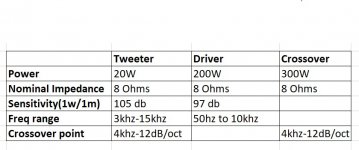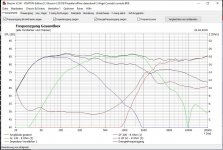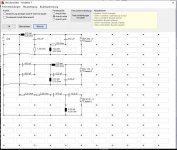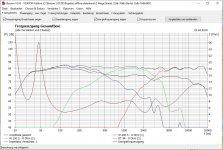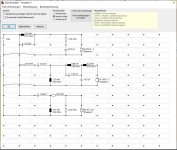Hi all....
Can you help me estimate the final impedance of a 2 way speaker please? (What is the logic to estimate final impedance by the way?)
The specifications of driver+tweeter+crossover are in the attached image.
Thanks a lot in advance.
audfrknaveen
Can you help me estimate the final impedance of a 2 way speaker please? (What is the logic to estimate final impedance by the way?)
The specifications of driver+tweeter+crossover are in the attached image.
Thanks a lot in advance.
audfrknaveen
Attachments
Hey,
Using a traditional series crossover, the two impedances do not overlap.
More here:
A Speaker Maker's Journey: Crossover Basics - Impedance
Using a traditional series crossover, the two impedances do not overlap.
More here:
A Speaker Maker's Journey: Crossover Basics - Impedance
Can you help me estimate the final impedance of a 2 way speaker please?
(What is the logic to estimate final impedance by the way?)
It's 8R below 4kHz, and also 8R above 4kHz, so it's 8R all the way.
Each crossover section increases its input impedance out of band.
I am beginner in diy..... particulary in electronics.
I am sure if two drivers are connected in series or parallel makes the impedance double or half.
But im not sure how the impedance gets effected by adding the crossover in between.
So you are saying the impedance of the total system remains 8. Is my understanding correct?
I am sure if two drivers are connected in series or parallel makes the impedance double or half.
But im not sure how the impedance gets effected by adding the crossover in between.
So you are saying the impedance of the total system remains 8. Is my understanding correct?
you are saying the impedance of the total system remains 8.
Yes. The key point is that each crossover section (taken separately) has 8R input impedance only
within its own pass band. Outside of its own pass band, the section's input impedance increases.
When the two sections are paralleled, at a given frequency one section will have 8R input impedance,
while the other section has a much higher input impedance. Together (in parallel) the result is 8R
throughout the frequency range. See the attached diagram.
This is approximate of course, unless the crossover has been specifically designed to have a constant
load impedance (hopefully resistive) for the amplifier.
Diagram is from: Bi-wiring - Some Results
Attachments
Last edited:
Using a traditional series crossover, the two impedances do not overlap.
Actually, this is incorrect. The driver impedances overlap, but are altered by the transfer function of the xover. If it is a traditional 'series' xover, the impedances usually short out in the stop-band. A typical 'Parallel' xover's impedance rises towards infinity in the stop-band.
Of course- this is all textbook reference ideal world information.
Later,
Wolf
Depending on the crossover, the resulting impedance can actually be far lower than the impedance of the driver itself. Usually it's higher though.
when you say "depending on the crossover" you mean the internal design of the crossover i guess.
For any crossover in real life the shunt and series element interactions will have its own contribution to impedance.
Consider a low-pass filter, which can be constructed with 1mH inductor and 30uF capacitor.
If you halve the inductance and double the capacitance the 'crossover point' remains the same but the transfer function and impedance changes quite a bit.
You can try this yourself in a free crossover simulator.
There are similar issues with midrange crossovers in three way speakers, which tend to be quite difficult to get right depending on drivers and transfer functions chosen.
Consider a low-pass filter, which can be constructed with 1mH inductor and 30uF capacitor.
If you halve the inductance and double the capacitance the 'crossover point' remains the same but the transfer function and impedance changes quite a bit.
You can try this yourself in a free crossover simulator.
There are similar issues with midrange crossovers in three way speakers, which tend to be quite difficult to get right depending on drivers and transfer functions chosen.
when you say "depending on the crossover" you mean the internal design of the crossover i guess.
The filter design has to fit the drivers. 'Universal' crossovers don't work because every driver got its own frequency- and impedance response, how it changes over the frequency range. The crossover can't 'know' how the driver behaves. Even with just 2 parts (2nd order, 12dB/octave (=double the frequency)) there are a lot of different pairings possible. If the fall off isn't steep enough or it got some ugly bumps or too soon drop in level, some developers don't use a compensation or a steeper filter (i.e. 3rd order, 18dB/octave), instead the serial coil of the woofer is chosen smaller and the capacitor to ground bigger. That works in some cases but at the same time it lets the impedance drop. If the developer isn't careful, the impedance might drop much further down than the plain 8-Ohm drivers might let it seem.
An example:
(Not my project)
Despite all drivers being 8 Ohm, the minimum impedance is just 3,5 Ohm at ~350Hz, overall clearly a 4 Ohm speaker.
The crossover.
Attachments
- Status
- This old topic is closed. If you want to reopen this topic, contact a moderator using the "Report Post" button.
- Home
- Loudspeakers
- Multi-Way
- What will be the final impedance of this drivers and crossover combination?
